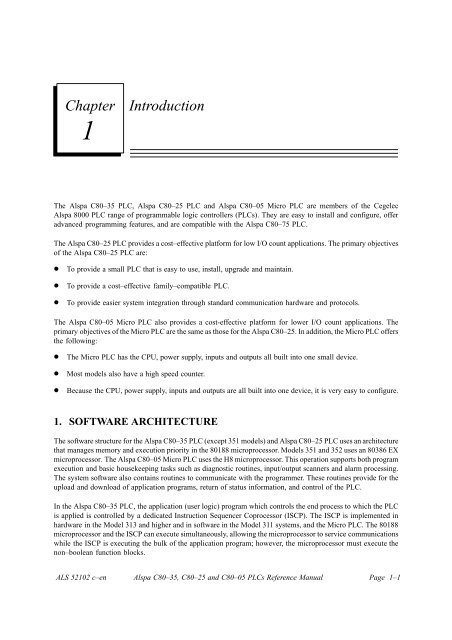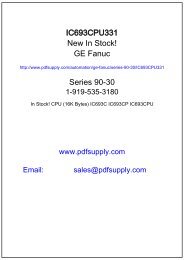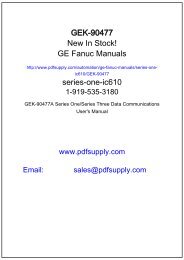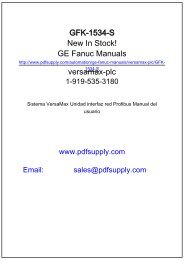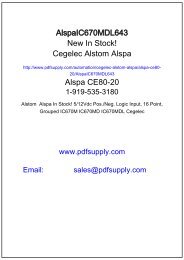Alspa C80-35 24 Vdc Input, Neg/Pos Logic, 1 ms ... - GE Fanuc PLC
Alspa C80-35 24 Vdc Input, Neg/Pos Logic, 1 ms ... - GE Fanuc PLC
Alspa C80-35 24 Vdc Input, Neg/Pos Logic, 1 ms ... - GE Fanuc PLC
Create successful ePaper yourself
Turn your PDF publications into a flip-book with our unique Google optimized e-Paper software.
Chapter1IntroductionThe <strong>Alspa</strong> <strong>C80</strong>–<strong>35</strong> <strong>PLC</strong>, <strong>Alspa</strong> <strong>C80</strong>–25 <strong>PLC</strong> and <strong>Alspa</strong> <strong>C80</strong>–05 Micro <strong>PLC</strong> are members of the Cegelec<strong>Alspa</strong> 8000 <strong>PLC</strong> range of programmable logic controllers (<strong>PLC</strong>s). They are easy to install and configure, offeradvanced programming features, and are compatible with the <strong>Alspa</strong> <strong>C80</strong>–75 <strong>PLC</strong>.The <strong>Alspa</strong> <strong>C80</strong>–25 <strong>PLC</strong> provides a cost–effective platform for low I/O count applications. The primary objectivesof the <strong>Alspa</strong> <strong>C80</strong>–25 <strong>PLC</strong> are:To provide a small <strong>PLC</strong> that is easy to use, install, upgrade and maintain.To provide a cost–effective family–compatible <strong>PLC</strong>.To provide easier system integration through standard communication hardware and protocols.The <strong>Alspa</strong> <strong>C80</strong>–05 Micro <strong>PLC</strong> also provides a cost-effective platform for lower I/O count applications. Theprimary objectives of the Micro <strong>PLC</strong> are the same as those for the <strong>Alspa</strong> <strong>C80</strong>–25. In addition, the Micro <strong>PLC</strong> offersthe following:The Micro <strong>PLC</strong> has the CPU, power supply, inputs and outputs all built into one small device.Most models also have a high speed counter.Because the CPU, power supply, inputs and outputs are all built into one device, it is very easy to configure.1. SOFTWARE ARCHITECTUREThe software structure for the <strong>Alspa</strong> <strong>C80</strong>–<strong>35</strong> <strong>PLC</strong> (except <strong>35</strong>1 models) and <strong>Alspa</strong> <strong>C80</strong>–25 <strong>PLC</strong> uses an architecturethat manages memory and execution priority in the 80188 microprocessor. Models <strong>35</strong>1 and <strong>35</strong>2 uses an 80386 EXmicroprocessor. The <strong>Alspa</strong> <strong>C80</strong>–05 Micro <strong>PLC</strong> uses the H8 microprocessor. This operation supports both programexecution and basic housekeeping tasks such as diagnostic routines, input/output scanners and alarm processing.The system software also contains routines to communicate with the programmer. These routines provide for theupload and download of application progra<strong>ms</strong>, return of status information, and control of the <strong>PLC</strong>.In the <strong>Alspa</strong> <strong>C80</strong>–<strong>35</strong> <strong>PLC</strong>, the application (user logic) program which controls the end process to which the <strong>PLC</strong>is applied is controlled by a dedicated Instruction Sequencer Coprocessor (ISCP). The ISCP is implemented inhardware in the Model 313 and higher and in software in the Model 311 syste<strong>ms</strong>, and the Micro <strong>PLC</strong>. The 80188microprocessor and the ISCP can execute simultaneously, allowing the microprocessor to service communicationswhile the ISCP is executing the bulk of the application program; however, the microprocessor must execute thenon–boolean function blocks.ALS 52102 c–en <strong>Alspa</strong> <strong>C80</strong>–<strong>35</strong>, <strong>C80</strong>–25 and <strong>C80</strong>–05 <strong>PLC</strong>s Reference Manual Page 1–1


